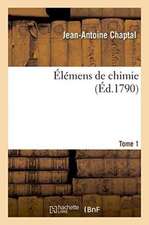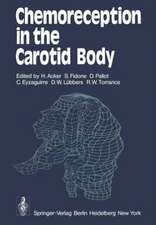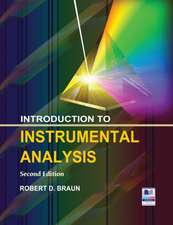Environmental Chemistry
Autor Colin Baird, Michael Cannen Limba Engleză Hardback – 29 feb 2012
| Toate formatele și edițiile | Preț | Express |
|---|---|---|
| Hardback (2) | 528.50 lei 22-36 zile | +110.87 lei 6-12 zile |
| MACMILLAN EDUCATION – 31 mai 2012 | 528.50 lei 22-36 zile | +110.87 lei 6-12 zile |
| W. H. Freeman and Company – 29 feb 2012 | 1681.20 lei 22-36 zile |
Preț: 1681.20 lei
Preț vechi: 2050.24 lei
-18% Nou
Puncte Express: 2522
Preț estimativ în valută:
321.69€ • 336.78$ • 266.18£
321.69€ • 336.78$ • 266.18£
Carte disponibilă
Livrare economică 17-31 martie
Preluare comenzi: 021 569.72.76
Specificații
ISBN-13: 9781429277044
ISBN-10: 1429277041
Pagini: 776
Dimensiuni: 196 x 234 x 36 mm
Greutate: 1.44 kg
Ediția:5
Editura: W. H. Freeman and Company
ISBN-10: 1429277041
Pagini: 776
Dimensiuni: 196 x 234 x 36 mm
Greutate: 1.44 kg
Ediția:5
Editura: W. H. Freeman and Company
Cuprins
PART I: ATMOSPHERIC CHEMISTRY AND AIR POLLUTION.- Stratospheric Chemistry: the Ozone Layer.- The Ozone Holes.- The Chemistry of Ground-Level Air Pollution.- The Environmental and Health Consequences of Polluted Air - Outdoors and Indoors.- PART II: ENERGY AND CLIMATE CHANGE.- The Greenhouse Effect.- Energy Use, Fossil Fuels, CO2 Emissions, and Global Climate Change.- Biofuels and Other Alternative Fuels .- Renewable Energy Technologies: Hydroelectric, Wind, Solar, Geothermal, and Marine Energy and Their Storage .- Radioactivity, Radon, and Nuclear Energy.- PART III: WATER CHEMISTRY AND WATER POLLUTION.- The Chemistry of Natural Waters.- The Pollution and Purification of Water.- Toxic Heavy Metals .- PART IV: TOXIC ORGANIC COMPOUNDS.- Pesticides.- Dioxins, Furans and PCBs.- Other toxic Organic Compounds of Environmental Concern .- PART V: ENVIRONMENT AND THE SOLID STATE .- Wastes, Soils, and Sediments .- PART VI: ADVANCED ATMOSPHERIC CHEMISTRY .- The Detailed Free-Radical Chemistry of the Atmosphere .- Appendix A: Oxidation Numbers and Redox Equation Balancing Reviewed.- Answers to Selected Odd-Numbered Problems.- Index.
Notă biografică
Descriere
Descriere de la o altă ediție sau format:
Colin Baird and Michael Cann's acclaimed Environmental Chemistry helps students explore the chemical processes and properties underlying environmental issues they hear about every day - climate change, pollution, biofuels, sustainability and more. Like no other textbook of its kind, it makes accessible the many ways chemists are tackling fundamental environmental problems – including those for which the chemical industry itself is a source.
With up-to-date, balanced, and authoritative coverage of soil, water, and air chemistry, the new edition again focuses on the environmental impacts of chemical production and experimentation, offering additional "green chemistry" sections and new case studies.
Updates include:
• Expanded coverage of energy production (especially biofuels), the generation and disposal of CO2, and innovative ways to combat climate change.
• Increased international coverage to give all students a better perspective on environmental problems and solutions around the world – for example, there is increased coverage of gaseous and particulate air pollution and CO2 emissions and air quality standards in different countries, both developed and developing ones.
• Updated Green Chemistry cases, including new cases on the development of bio-based toners; recycling carbon dioxide; a non-volatile, reactive coalescent for the reduction of VOCs in latex paints; bio-based liquid fuels and chemicals; and
spinetoram, an improvement on a green pesticide.
• An Activity has been inserted into each chapter – these web- or library-based mini-projects could be assigned to individual students or to a group of them to accomplish and report on.
• More schematic diagrams have been added to promote student comprehension of the more complicated chemistry and appeal to a variety of learning styles.
• Marginal notes – to supplement the main text with additional interesting material, and to indicate which Review Questions are relevant to the material at hand.
Colin Baird and Michael Cann's acclaimed Environmental Chemistry helps students explore the chemical processes and properties underlying environmental issues they hear about every day - climate change, pollution, biofuels, sustainability and more. Like no other textbook of its kind, it makes accessible the many ways chemists are tackling fundamental environmental problems – including those for which the chemical industry itself is a source.
With up-to-date, balanced, and authoritative coverage of soil, water, and air chemistry, the new edition again focuses on the environmental impacts of chemical production and experimentation, offering additional "green chemistry" sections and new case studies.
Updates include:
• Expanded coverage of energy production (especially biofuels), the generation and disposal of CO2, and innovative ways to combat climate change.
• Increased international coverage to give all students a better perspective on environmental problems and solutions around the world – for example, there is increased coverage of gaseous and particulate air pollution and CO2 emissions and air quality standards in different countries, both developed and developing ones.
• Updated Green Chemistry cases, including new cases on the development of bio-based toners; recycling carbon dioxide; a non-volatile, reactive coalescent for the reduction of VOCs in latex paints; bio-based liquid fuels and chemicals; and
spinetoram, an improvement on a green pesticide.
• An Activity has been inserted into each chapter – these web- or library-based mini-projects could be assigned to individual students or to a group of them to accomplish and report on.
• More schematic diagrams have been added to promote student comprehension of the more complicated chemistry and appeal to a variety of learning styles.
• Marginal notes – to supplement the main text with additional interesting material, and to indicate which Review Questions are relevant to the material at hand.
Caracteristici
Increased international coverage
New and updated Green Chemistry cases
New 'Activities' feature
More user-friendly text structure
New and updated Green Chemistry cases
New 'Activities' feature
More user-friendly text structure
Caracteristici noi
UPDATED COVERAGE
Green Chemistry coverage expanded
Increased international coverage
New 'Activities' feature
MORE USER-FRIENDLY TEXT STRUCTURE
Green Chemistry coverage expanded
- With several new and updated Green Chemistry cases, for example:
- Reduction of VOCs (Volatile Organic Compounds) in paints and coatings
- Using waste carbon dioxide as a feedstock for the production of chemicals and liquid fuels
- Spinetoram, an improvement on a green pesticide
- Toners for copy machines produced from bio-based materials
- The production of liquid fuels and chemicals from biomass
Increased international coverage
- More examples and data from countries outside North America are used to show how the chemistry and techniques are being applied to real world problems.
- Chinais now especiallyhighlighted in many places.
- Afew topics of interest mainly in developing countries - such as the new wood stoves - have also been added.
New 'Activities' feature
- An Activity has been inserted into each chapter; these could be assigned to individual students or to a group to accomplish and report on.
MORE USER-FRIENDLY TEXT STRUCTURE
- 'Water Chemistry and Water Pollution' is now covered before 'Toxic Organic Compounds' so that Water Chemistry is being covered earlier and falls in line with preferred teaching sequences. This also means that the Organic material is covered later and can be eliminated depending on the module's depth and students' background.
- Detailed mathematical material repositioned to the end of chapters in many cases, so coverage does not appear to be mandatory or interrupt the flow of the main text.
- More hints and background on the more difficult in-text and Additional Problems
- New Marginal notes add interesting points to the main text material, indicate which Review Questions and Additional Problems are relevant to the material at hand, help recall the reactions being discussed, and show miscellaneous structures, etc.
- Streamlined by moving the Organic Chemistry appendix to the website, and by removing the Scientific American Readings as well as the Additional Reading lists at the end of chapters, as these became out-of-date too quickly
- Other layout improvements for readability
- Text broken into smaller subsections and shorter paragraphs, to help understanding
- Italicized text emphasizes the most important statements, including conclusions, and summaries within subsections
- Greater use of bullets, for points most readily covered in a list or sequence
- Subsection numbering, allows lecturers to assign material to be covered/skipped more easily

















